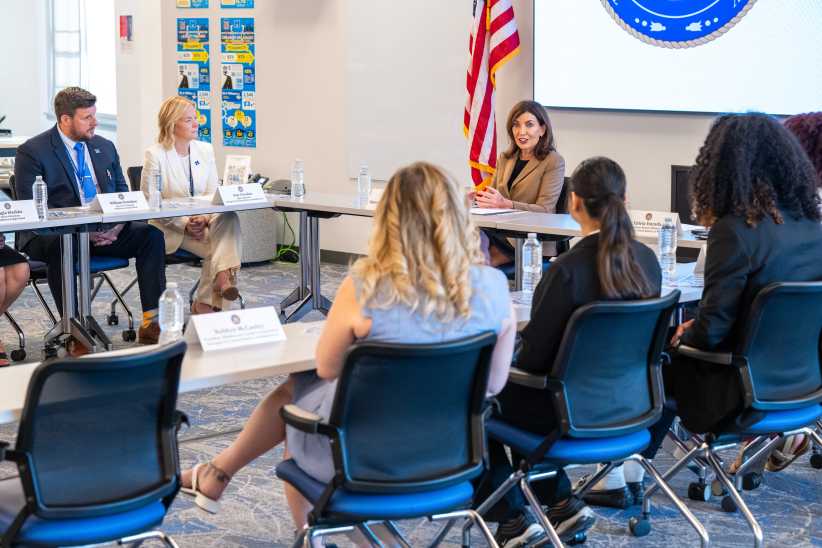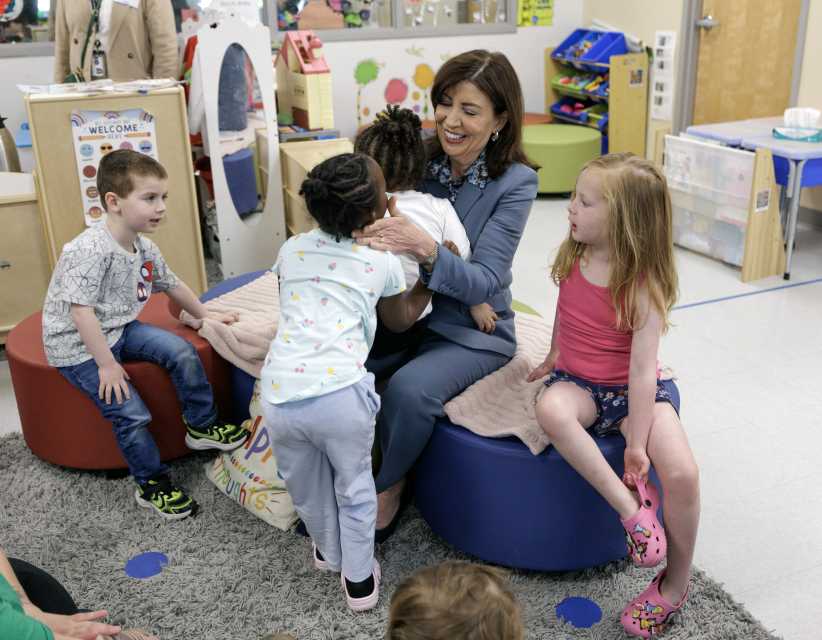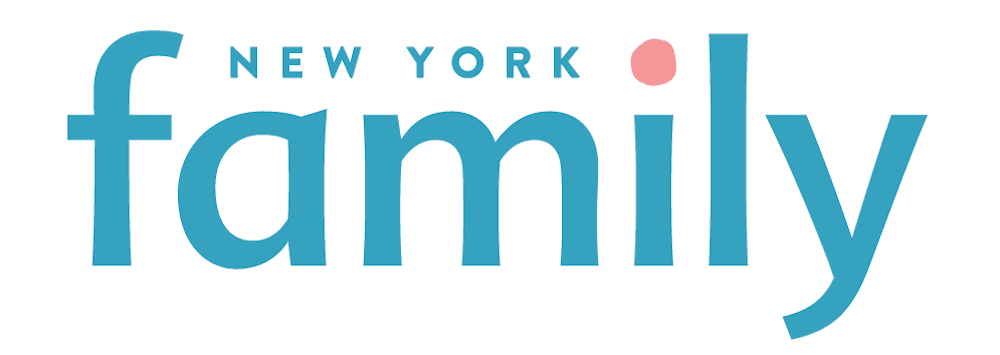
Exclusive: Governor Kathy Hochul’s Fight for New York Families
The exclusive on school cell phone bans, child tax credits, and other family-first initiatives.
New York State Gov. Kathy Hochul is a woman who wears many hats. When she’s not rolling out free community college for New Yorkers 25 and older while wearing her famed Chuck Taylor Converse sneakers, she’s enjoying a ferry boat ride with breathtaking views of the city she loves.
Psst…Check Out Inflation Refund Checks Are Coming to NYC Parents in October, Plus New Child Tax Credit Increase!
Over the past year, Governor Hochul has implemented numerous bills and programs aimed at supporting New York families. Ahead, Hochul gets candid about the positive changes she’s determined to make for New York families – from cell phone bans in schools to child tax credits that would put money back in parents’ pockets.

Q: You recently banned cell phone use in all New York schools. Can you tell us more about that decision?
A: The decision came about after a journey I set forth on, and that was to try to figure out what was happening to our young people. I saw that there was a rise in cell phone use over the last decade in schools, and that coincided with the increase in addictive algorithms that were bombarding our children. They’re so anxiety-driven by this fear of missing out, and even during the school day, students are not listening to their teachers, and children are not absorbing information.
I did round tables from the north country way on the Canadian border, all the way to Long Island, Western New York, and New York City. I heard the same thing. I convened schools, superintendents, principals, teachers, parents, and students. I listened to teenage girls in one high school describing the enormous pressure of being bullied, and I realized, you know what? We have to do something. And one young woman told me, “You’ve gotta save us from ourselves. We can’t put these down.”
Q: What outcome do you hope to achieve from the ban?
A: I’m energized by this. Two years ago, I was at a school that decided to go distraction-free. Cell phones had to be locked up in a yonder pouch at the beginning of the day; there were set ways for parents to reach their children during the day if needed. If there’s an emergency, kids could reach their parents, but not on a digital device. That school was fascinating. The results and academic outcomes were already improving. The teenagers I spoke to said they have friends in person, and there’s noise in the hallways. They’re talking to each other at lunchtime, and they feel so much more liberated. They feel like kids again.
I know what we’re going to do here is going to be profound. There will be some challenges, cause change is hard, but we’re breaking an addiction. I’m working with parents and telling them to start winding the kids down this summer, have cell phone-free days in their home, and get them acclimated to the idea. For two years, we’ve been promoting “Get Offline, Get Outside” and investing in swimming pools, summer youth programs, and community centers, as well as promoting our parks and outdoor life. We’re letting the kids know there’s a whole other world outside, sitting in their bedroom all summer long and staring at their cell phone.”
Q: The ban is part of a larger initiative to address mental health in teenagers. What impact does screen time have on our kids, and what signs should parents look for?
A: The mental health of our kids is far worse than it was when I was growing up or even when my kids were growing up. We are getting higher than expected rates of suicide, suicidal thoughts, depression, anxiety, even from very young ages. I was in an elementary school, and the nurse told me that they have very young children, even from first grade, who are starting to need healthcare services. We cannot let this happen. Protecting our kids’ mental health is everything to me because I’ve seen how hard it is on my nieces and nephews, family members, and friends. I know how bad it has been for our kids, and it has to stop.

Q: You recently proposed a child tax credit to help ease the financial burden on New Yorkers. Why was this such an important bill for you to pass?
A: Affordability is one of my top priorities. When I put together my state of the state address in January, I leaned hard into my strong message: your family is my fight.
I understand the stress families, especially young parents, are going through. I lived through that. I lived at a time when I couldn’t find childcare, couldn’t find anything. My babies were born, and I had to leave my job. My husband was working for the government, so our income went down by half, and we struggled. I went to the store trying to buy discount diapers and formula, my hand clutching coupons, hoping that we could get through another week. It was hard on us. I know what it was like to sacrifice.
Parents today are seeing kids outgrow everything so fast, so I said, ‘How can I take off some of that stress on young families?’ When I first became governor, we didn’t have a child tax credit for children under the age of four. As a mom, that is one of the most expensive times in their lives. They outgrow everything so fast, and they’re not eating regular food; everything is expensive. So we decided to have $1,000 for every family with children under age 4, and $500 for children ages 5 through 16. That’s money back in families’ pockets.
Another part of our affordability agenda is an inflation rebate. I walked through Target’s back-to-school shopping last year. This year, I see the moms comparing prices on everything, from sneakers and backpacks to clothes. It is hard. So $400 back for families making less than $150,000 is to help them pay for those back-to-school products their kids need.
Some people just can’t get ahead, and I will continue fighting for our families because I’ve lived that experience.

Q: What other support systems are out there for New Yorkers who may be struggling financially?
A: Another big driver of costs of living is utility bills, so we have programs to help cover the costs of utility bills for families. For people who want to change their circumstances, better themselves, and be able to support their families more fully by getting an education, we’re covering the full cost of community college tuition for ages 25 to 55.
I’m building more affordable housing to help open up opportunities for more people to have a safe roof over their heads. We have more to do, but I have been to projects from Gowanus all the way up to Buffalo, and when I see a family, a formerly homeless mom with her teenage kids, opening up the door for the first time, and I hand them the key, the look on their face is just beautiful. We’re trying to hit all those pressure points our families are suffering under now.
Q: You recently announced a $300 million healthcare fund for New Yorkers. What kind of health concerns are you hoping to address?
A: Our hospitals and community health providers are the first places people go when they don’t have a primary care doctor. Every person has the right to healthcare. We’re making these investments to build up the infrastructure and cover those costs for our healthcare institutions.
At the same time, we have the Trump administration cutting Medicaid, which is going to devastate so many hospitals across our state. That’s what we’re fighting against – healthcare workers losing their jobs and people having to survive without guaranteed healthcare. That’s scary for a parent. Your child gets sick, that’s your worst nightmare. This money will help stabilize our healthcare institutions and make sure they’re there when people need them, and fight back against what Donald Trump is doing.
Q: What can New York families expect from the Hochul administration for the remainder of this year and next?
A: Well, we’ll save that as a surprise for our next state of the state. We’re developing it now. But I assure you that public safety and affordability will continue to be the drivers of that. We’re not done yet. Families are still struggling, and that is my mission as someone who, again, can relate. Specifically, I know how expensive childcare is, especially because of my own upbringing and my early years as a mom and a grandma. We’ve talked about universal childcare. We’ll be hearing more details about that and how it is going to play out. It’s critically important to give a lifeline to our parents.
Psst…Check Out Gov. Kathy Hochul Announces New Website for School Cell Phone Ban














